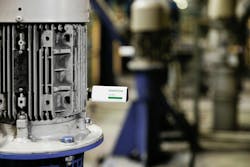Maximizing motor reliability: best practices for bearing installation and vibration monitoring
Key Highlights
- Proper storage in climate-controlled environments and careful handling prevent coating damage and misalignment during installation.
- A variety of tools—hydraulic, mechanical, thermal, and alignment—are essential for precise bearing mounting and dismounting, reducing mechanical shocks and damage.
- Vibration technology like Schaeffler's OPTIME detects early signs of bearing wear, misalignment, and lubrication issues.
- AI and smart sensor networks facilitate real-time condition monitoring, dynamic alarm adjustments, and automated reporting.
- Future advancements include condition-based greasing, AI-generated reports, and adaptive alarm limits.
For maintenance teams, reliability begins long before a motor starts up—with how a bearing is stored, installed, and aligned. A small installation error or a cracked coating can cascade into premature wear, vibration, and failure.
As industrial operations rely more on ceramic-coated and hybrid bearings to handle higher loads and variable frequency drive (VFD) applications, precision installation has become essential for ensuring uptime and equipment longevity. Ericka Kauer and Frank Mignano of Schaeffler Group, discuss proper bearing handling and mounting techniques and how to select the right hydraulic, mechanical, and thermal tools, and advanced vibration analysis systems to detect early signs of misalignment, lubrication breakdown, or bearing defects.
With plants evolving toward more connected and data-driven reliability programs, Schaeffler continues to expand its use of AI-driven diagnostics and condition-based lubrication.
Read more from Schaeffler Group: Stop bearing failures before they start: what every maintenance team should know about VFD effects
Bearing storage and installation best practices to prevent premature failure
Proper storage and installation are critical steps in ensuring bearing performance and longevity. Even the most advanced ceramic-coated bearings can fail prematurely if exposed to moisture, misalignment, or improper mounting forces. Using the right tools—hydraulic, mechanical, thermal, and alignment—helps protect bearing coatings, maintain precision fits, and prevent avoidable damage during installation.
A ceramic coated bearing should be protected against humidity during storage, and a climate-controlled environment is recommended for storage of any kind of bearing. “The bearing doesn’t need to be handled with the most care, because it’s not brittle, but you want to ensure that there are no cracks in the coating during installation, so we would advise not using hammers and very severe mounting techniques,” Kauer says.
Mignano outlines the different types of tools and categories for mounting bearings:
- “Hydraulic tools provide controlled force for mounting/dismounting large or tight fit components without mechanical shock,” he says.
- Hydraulic nuts are used for the precise axial drive-up of bearings, sleeves, and couplings on tapered seats.
- High-pressure hand pumps and oil injectors generate the pressure required for hydraulic nuts and the oil injection method.
- Hydraulic withdrawal/mounting sleeves facilitate the removal of bearings and sleeves using a pressurized oil film.
- “Mechanical tools are used for general installation and removal tasks, locknut handling, and safe application of mechanical force,” he says.
- Puller sets, which include two-arm/three-arm pullers, hydraulic-assist pullers, and split-ring pullers, remove bearings, gears, and pulleys.
- “Thermal tools expand rings or housings to reduce mounting force and avoid mechanical damage,” he says.
- A bearing induction heater is a precision tool designed to safely and efficiently heat bearings, couplings, gears, and other shrink-fit components. “Unlike ovens or oil baths, which heat the surrounding environment or medium, induction heaters generate heat directly inside the bearing itself using electromagnetic fields,” he says.
- “Alignment tools can improve machine reliability by reducing misalignment-induced loads on bearings and equipment,” he says.
- Laser alignment tools are used for quick and accurate shaft alignment in rotating machines, measuring and adjusting belt tension, and aligning belt pulleys.
Advanced vibration technology for predictive bearing maintenance
Effective bearing maintenance begins with understanding the subtle signals machines give off before failure occurs. Vibration technology, like Schaeffer’s OPTIME, allows maintenance teams to detect early signs of bearing wear, misalignment, or lubrication issues—long before they lead to costly downtime.
“A lot of this vibration technology is geared toward finding bearing defects because bearings take the brunt of the abuse on the equipment,” Mignano says. “It’s all transmitted through the bearings. Unbalanced alignment, looseness, resonance, the different things that can happen on a piece of equipment, all that affects the life of the bearing.” The Schaeffler OPTIME system captures seven different measurements—six of those are vibration, which each focus on a different part of the machine. OPTIME captures the following six KPIs:
- ISO Velocity – standard alarm levels have been decided for decades
- DEMODulation – focuses on bearing defects & lubrication issues
- RMS low – a filtered acceleration reading from 2 HZ to 750 Hz
- RMS high – a filtered acceleration reading from 750 Hz to 5,000 Hz
- Kurtosis low – to capture spikiness in the waveform 2 – 750 Hz
- Kurtosis low – to capture spikiness in the waveform 750 – 5000 Hz.
“They each tell us a little bit different information about what’s going on with the machine,” Mignano says. “When we see a trend start to climb and demodulation, for example, we know something is going on with the bearing. We’re seeing some sort of metal-to-metal contact.”
Demodulation, he says, is a signal processing technique that uses filtering and waveform rectification, and vendors all have their own versions. Schaeffler’s DEMODulation trend is a demodulation measurement that can alert to different changing conditions in the bearing, such as raceway defects or lubrication issues (contamination or lack of lubrication) or metal-metal contacting. “The FFT [Fast Fourier Transform] or spectrum of the processed DEMOD waveform allows us to pinpoint the defect to the specific raceway of the bearing or even the cage or rolling elements, if they are the failing component,” Mignano says.
In general, different-sized machines have a long-standing standard for vibration velocity. Outside of those standard limits, at lower frequency vibrations, unbalance, alignment, and looseness issues will show. Mechanical stresses, hydraulic problems, and electrical defects can all contribute to premature motor failure if not properly monitored.
“Pipe strain from over tightening can put the whole motor pump train out of whack,” Mignano says.
“Cavitation is caused by a lack of liquid upstream from the pump that is cavitating. When you stand near a pump that is cavitating it can sound like there are rocks in the pumps. It means two things; the pump is not operating properly, and there is damage being caused to the pump itself,” Mignano says.
Mignano says typical industrial motors can have between 50 to 70 rotor bars inside the motor. “Rotor bars are insulated components of the motor. If the insulation starts to wear (or another defect occurs), we can see this in the vibration FFT in this range, out near 50-70 times shaft speed,” he adds.
Smart sensor networking and AI trends in predictive maintenance
As connectivity is the backbone of modern condition monitoring, Schaeffler’s OPTIME system, is built on a self-healing, data-rich network, and looking ahead, advances in artificial intelligence (AI), dynamic alarm limits, and automated reporting promise to make predictive maintenance even smarter, more adaptive, and easier to integrate into daily reliability routines.
In partnership with Wirepas, the OPTIME system uses Wirepas’ decentralized mesh technology, which is built for massive scale IoT deployments. “All of our sensors are also repeaters, so we can go from gateway to a sensor 100 meters line of sight, and from that sensor to the next sensor, we can go another 100 meters and another 100 meters. They all talk to and through each other,” Mignano says.
The network has 40 different channels on which to send data. “It’s constantly looking at which roads are busy and which path is open, and it optimizes the data transfer in that way,” Mignano says.
“It’s a self-healing network, meaning that the sensors would automatically detect the next best path to the gateway through other sensors, and it reroutes automatically,” Kauer says. This feature is especially helpful when making changes to the system, and no setup is locked into the initial framework. “It constantly reroutes and find the most appropriate path,” Kauer says.
Schaeffler is also spending a lot of time improving its application of AI and its algorithms. Its current models can capture the speed of the shaft without a tachometer to measure. “We can pull that information out of the vibration signature,” Mignano says.
However, Schaeffler wants to push the algorithms further, looking to develop condition-based greasing, where readings from the vibration sensors can tell the lubricator when it needs to grease the bearings.
The manufacturer is also looking to develop dynamic alarm limits, for customers that make different products lines and sizes, which affect machines differently. Once the vibration signature changes with a new product, the system will automatically change the alarm limits to match that new product run.
In the future, Schaeffler will also release an AI report generator to pull information from a system’s data. “Anything you can think of to pull out of that data, it’s going to pull up a nice plot and different ways to view that information,” Mignano says.
The AI Report generator allows users to query the entire database to look for trends such as how many active sensors per plan, how many sensors with severe alarms, low batteries, and lubrication levels. The reports can be set up to automatically generate on a specific day of the week or every day and emailed to your inbox. “This allows the data to be integrated into morning or weekly reliability meetings if something concerning is occurring on a critical asset, Mignano says, and the reports are customizable to the specific user (as the plant manager typically would like a different set of parameters versus a technician or service provider).
About the Author

Anna Townshend
managing editor
Anna Townshend has been a journalist and editor for almost 20 years. She joined Control Design and Plant Services as managing editor in June 2020. Previously, for more than 10 years, she was the editor of Marina Dock Age and International Dredging Review. In addition to writing and editing thousands of articles in her career, she has been an active speaker on industry panels and presentations, as well as host for the Tool Belt and Control Intelligence podcasts. Email her at [email protected].

